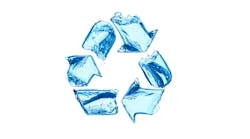Would we ask the local public safety authority to turn down the volume on the tornado siren so it won’t disturb our sleep? If a bus were about to run us down in the street, would we want an onlooker to whisper, “Look out?” Of course we would say, “Turn it up and shout it out!” Then, why in marketing meetings all around the country do corporate managers tell their marketing staff to tone it down and be careful not to scare people about the dangers of arsenic in the water? The notion is to be gentle when you deliver the message.
It is because in this age of sensationalism, reality TV and over exaggeration companies strive to appear serious and avoid any chance of beginning tagged as a fear monger — a harbinger of doom. But where do we draw the line? When do we just say, “It’s arsenic people, don’t drink it!”
As water professionals, we know the seriousness of hazardous materials in water. We are genuinely concerned about people. We know that clear water does not mean safe water. Just because it looks good and is refreshing to drink doesn’t mean it is good for you. In an attempt to not scare anyone, but inform people on the dangers of arsenic in water, here are some facts and research finds. If we frighten anyone, please accept our sincerest apology.
Facts about arsenic
What is arsenic and where did it come from, and why are we just hearing about it now?
Arsenic is a naturally occurring mineral in groundwater. It is found in water all over the world as both As3 (arsenite) and As5 (arsenate). In Bangladesh it is truly a health crisis.1 In South America, 7,000-year-old Andean mummies showed the effects of arsenicosis (arsenic poisoning) from prolonged exposure to contaminated drinking water. Europe was the first to lower their arsenic levels to 10 parts per billion (ppb). Even in the U.S. there is arsenic in the drinking water supply. In most every case, it is not a man-made problem. It has always been there, people were just unaware of its presence. It is tasteless, colorless and odorless.
This is not to say that there are no man-made sources of arsenic contamination. In the dust bowl of the 1930s, they used white powdered arsenic as a pesticide to control the swarms of grasshoppers plaguing the Midwest.2 Arsenic is a by-product of wood preservative, gold mining and other industrial uses, but these sources of arsenic are isolated and fairly rare. Most of the problems are Mother Nature.
Setting the standard for arsenic
The reason the public was unaware of an issue with this hazard was the ability to test very small levels of arsenic. For decades, the Maximum Contaminant Level (MCL) set by the Environmental Protection Agency (EPA) was 50 ppb. To put ppb in perspective, it is one single drop in the largest tanker trucks used to haul gasoline.
Even at these low levels, research showed that 50 ppb of arsenic (As) is too high. The reason the MCL was set at 50 ppb was because this was as low as the test equipment could detect. In 1975, the EPA set the standard of 50 ppb based on a Public Health Service standard originally established in 1942. In 1999, the Academy of Science concluded that 50 ppb was non-protective and recommended an immediate reduction of the standard. President Bill Clinton called for a reduction in the standard in 2000. In 2001 the EPA, in accordance of Public Law 106-337, issued a final change in the standard of 10 ppb.
When the EPA first looked at revising the MCL for arsenic, it initially considered 5 ppb. At this level the EPA estimated that they would protect 22.5 million Americans currently on public water supplies containing arsenic. The EPA decided to follow the World Health Organization (WHO), who set the maximum contaminant level MCL at 10 ppb and settled on a standard of 10 ppb, which is estimated to protect 13 million people on public water supplies. New Jersey and South Carolina both accepted the 5 ppb level for their residences.
The 10 ppb MCL does not necessarily come from a science point of view. In March 2001, Christie Whitman (the Environmental Protection Agency administer) suspended the 5 ppb standard and directed the EPA to conduct a cost-benefit analysis for a new standard ranging from 3 to 20 ppb. Based on cost-benefit facts, they choose 10 ppb as the new standard. According to a Fox News article, “Arsenic in drinking water deemed ‘safe’ could harm mothers and children, study finds.”
Problems from arsenic
This ruling does nothing for the millions of people on private water supplies or the people with water supplies below 10 ppb, but above the original level of 5 ppb. Once technology could test lower levels of arsenic they discovered some disturbing evidence that ingesting arsenic as low as 0.17 ppb long term can result in arsenicosis.3 Ingesting water with just 1 ppb for an extended period can cause endocrine disruption.4 Endocrine disruptors are chemicals that interfere with endocrine (or hormone system) in animals, including humans. These disruptions can cause cancerous tumors, birth defects and other developmental disorders.5 WHO defines arsenicosis as a “chronic health condition arising from prolonged ingestion (not less than six months) of arsenic above a safe dose, usually manifested by characteristic skin lesions, with or without involvement of internal organs.”6
June 1, 2012, Fox News described a report from the Marine Biological Laboratory and the Geisel School of Medicine at Dartmouth University on the EPA arsenic standard of 10 ppb. In the report researchers found that after giving 10 ppb water to pregnant and/or lactating mice that the mothers experienced problems with their lipid metabolism, which caused lower levels of nutrients in their blood and breast milk. These nutrient deficiencies lead to growth and developmental deficiencies in their offspring while they were still breastfeeding. Read more at http://www.foxnews.com/health/2012/06/01/arsenic-in-drinking-water-deemed-afe-could-harm-mothers-and-children-study/#ixzz1wvUXPdI0.
History of arsenic
Knowledge of arsenic has a long history. For centuries, people used arsenic as a medicine, a pigment, a cosmetic, on mirrors and most notably as a deadly poison. Arsenic was the perfect poisoner’s tool because it is tasteless, colorless and odorless. Arsenic’s reputation as a poison outweighs its uses in medicine and technology. One interesting point of history is the discovery that Napoleon was a victim of arsenic poison likely caused by his wallpaper. Scheele’s Green (the inventory) was a coloring pigment used in fabrics and wallpapers from about 1770. While in exile on the island of St. Helena, the wallpaper in his room was Scheele’s Green. Others, including his butler, complained about the “bad air” in his room and the butler also perished.
The final verdict of Napoleon’s demise was death by green wallpaper. In the damp climate on St. Helena the wallpaper got wet and released arsenic into the air. Napoleon is believed to have breathed the air and poisoned himself. Arsenic is “toxic” and is difficult to diagnose in small doses over prolonged periods. There is no good reason not to be aware of the arsenic levels in one’s drinking water.
Arsenic treatment
Widespread arsenic contamination of groundwater in India and Bangladesh and neighboring countries is causing a massive epidemic of arsenic poisoning. As of November 2010, there are 42 major incidents around the world of reported groundwater arsenic contamination. Arsenic is a global issue with approximately 175 million people affected in over 30 countries.
What can you do? It is simple to test the arsenic level in drinking water. Most accredited labs offer arsenic testing. Some companies offer free arsenic screening for people on private water sources. A public water supply must report the arsenic level in their water. If arsenic is found in a water supply, it becomes crucial to conduct further testing to determine the level of silica, phosphate and discover the acidity or lack of acidity (pH) of the water. In addition, accurately identifying the arsenic species is crucial to developing a removal strategy. Not every technology removes both As3 and As5 from water, i.e. reverse osmosis is only effective on As5. In addition, the capacities of most adsorptive media for As3 species are much lower than the capacity for As5. All these things affect the technologies used to remove arsenic from water.
Depending on the source water chemistry, there are several technologies currently in use for arsenic removal. Some of the current useful technologies for removing As are:
- Iron and titanium based adsorption media filters
- Most remove As3 and As5
- Coagulation and filtration – As5 only
- Reverse osmosis – As5 only.
Each region of the country has different water chemistry. Therefore, as a water treatment professional it is important to do one of two things: Test the water quality or throw the kitchen sink at the problem.
Arsenic removal is not complex; it is simple and easy when you know the water quality. As stated above, there are a number of effective ways to remove arsenic, but choosing which arsenic removal technology to use is dependent upon more than just the arsenic concentration. The problem most professionals run into is assuming the water is clean except the arsenic. The majority of water professionals work with labs on a regular basis. Those labs can provide services that will test for those competing ions. Arsenic is present in more water than people realize so to work with those labs and incorporate those test parameters will be useful and profitable.
There are even many handheld devices that will test for silica, phosphate, pH, iron and manganese as well. The key thing is if you do not test for these parameters (As3 included), then throw the kitchen sink at the problem. For a simple test you can save the end user money in replacement equipment or unnecessary equipment.
Once you know the water quality, then you as the water treatment professional can provide the right treatment. The purpose of this article is to point out that it’s better for the consumer (homeowner) to treat their arsenic then to ignore the issue.
There have been a number of articles and papers discussing POU vs. POE. Forget the studies and dermal exposure and increase levels of arsenic. The quickest way for arsenic to enter your body is by ingestion. Arsenic does not disappear when you boil it or when you brush your teeth. It is in the water until it is removed by filtration. So when considering POU vs. POE, consider who is in the house. How many of you when you were younger drank water from faucets other than the one at the kitchen sink?
As water treatment professionals, we need to understand the dangers of arsenic and believe the research before we can access the importance of reducing this level one contaminant to below 10 ppb for our water. Do your homework and find knowledgeable water professionals to assist in the process. Take a look at: http://www.dartmouth.edu/~toxmetal/index.html or search YouTube: In Small Doses: Arsenic. This is an eye-opening video produced by Dartmouth College and The Toxic Metals Superfund Research.
As far as current research on the 10 ppb standard, they gave this level of arsenic to lab animals and bad things happened.
References:
- Bangladesh (2012). Water.org. Retrieved from http://water.org/country/bangladesh.
- EPA plans to clean up southeastern North Dakota’s arsenic-laced water supply (2003). Retrieved from http://www.uswaternews.com/archives/arcquality/3epapla11.html.
- UNICEF Arsenic Primer (2008). United Nations Children’s Fund (UNICEF), New York.
- Dartmouth College (2009). In Small Doses: Arsenic. Dartmouth Toxic Metals Superfund Research Program. Retrieved from http://www.dartmouth.edu/~toxmetal/InSmallDoses/.
- http://www.foxnews.com/health/2012/06/01/arsenic-in-drinking-water-deemed-afe-could-harm-mothers-and-children-study/#ixzz1wvTlMNiPon.
- Water-related Diseases (2001). Retrieved from http://www.who.int/water_sanitation_health/diseases/arsenicosis/en/.
- Arsenic poisoning and Napoleon’s (1995) death. Retrieved from http://www.victorianweb.org/history/arsenic.html.


